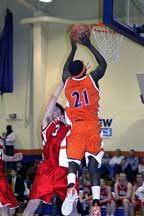
Basketball: Aerobic Intervals - A Better Way to Improve Fitness in Basketball Players
While not traditionally viewed as an endurance sport, recent research has shown that basketball places a high demand on the cardiovascular system. The study also suggests that lack of aerobic fitness is often a limiting factor in the sport and an improvement in aerobic fitness can pay huge dividends in the level of play of most basketball players.
As described in recent soccer research (see "Soccer - Use Aerobic Interval Training for Soccer Fitness"), one of the most effective ways to improve cardiovascular fitness is through aerobic interval training, similar to that used by middle distance and distance runners.
In fact, only two 25-minute workouts a week will significantly improve your players' endurance levels and make them hard to beat in the closing minutes of your games.
The Cardiovascular Demands of Basketball
The study, conducted at the Victoria University of Technology in Australia, revealed the extent to which the aerobic system is involved in basketball play. It monitored eight players from the Australian national basketball league (three guards and five forwards or centers) during typical league or practice games. These games involved four 12-minute quarters with two-minute breaks between quarters and a 15-minute break at halftime.
It was found that players averaged 105 high-intensity efforts per game, with each effort averaging 14 seconds in duration. These efforts include anything from sprinting to backwards running to sideways shuffling.
As a result, a basketball game is similar to performing a runner's interval workout involving 105 x 14-second repetitions with short recoveries of only 21 seconds!
Because of this, players achieve very high heart rates while on the court. For example, during play, the players' average heart rate was 89% of maximum. Heart rates exceeded 95-100% for 15% of the time they were on the court; 90-95% for 35% of their playing time; and ultimately averaging more than 85% of max for 75% of their court time.
In fact, players' heart rates stayed high even during free-throws, with heart rates remaining at about 90% of maximum.
Basketball players also experience high lactate levels during games. Levels as high as 13 mM/liter were reached - similar to the levels reached by elite 400 meter runners in a race.
While the average basketball players V02 max was relatively high (61ml.kg), the researchers indicated that there was definitely room for improvement. And, as with soccer, endurance-runner type workouts were suggested as the most effective methods for developing basketball players' fitness levels.
Aerobic Interval Workouts for Basketball Players

Only two workouts per week need be dedicated specifically to aerobic fitness. With some of these workouts taking less than 25 minutes (plus warmup and warmdown), they can be fit into most practice schedules - especially in the early season.
- 4 x 4 minutes at 90-95% of maximal heart rate, with a 3-minute jog between each repetition for recovery. This 25-minute workout, when performed twice per week for eight weeks, was shown to increase V02max by as much as 11%, velocity at lactate threshold by 21%, and running economy by 6.7%. These are all highly significant gains that should lead to huge improvements in performance - especially in the final quarter of a game.
- The 30-30 workout, in which players alternate 30 seconds of running as fast as possible, with only 30 seconds of jogging for recovery. Start with 10 repetitions, and progress to more reps as your players become more fit.
- Three minutes fast running separated by three minutes of easy jogging, for 3-5 repetitions. The pace of the faster sections is determined by a six-minute test, in which players run as far as they can in six minutes. Divide the distance run by two to determine how far they should run during each three-minute repetition.
Expected Improvements
While a study on game-specific improvements for basketball has yet to be performed, soccer players have similar fitness requirements and research has been performed on them. Soccer players trained using these methods increased the amount of distance they could cover in a game by 20%, and increased their contacts with the ball by 24%. They were able to perform at a higher heart rate during games, and were able to play at a higher intensity level for a significantly longer period of time.
What Aerobic Intervals Won't Improve
While aerobic interval training will improve your basketball players' endurance, it won't improve abilities that require power, such as squatting strength, bench press strength, sprint speed, jumping height, kicking velocity, or the ability to shoot or pass. On the positive side, the study showed that aerobic endurance training had no negative effects on these abilities.
References: 1. Owen Anderson, PhD, Lactate Liftoff, 2nd Edition, 2006. http://www.rrnews.com/ 2. Owen Anderson, PhD, Soccer fitness training: "Endurance Training Boosts Performance in the Field," Peak Performance Online, 2/23/08. http://www.pponline.co.uk/encyc/soccer-fitness.htm
To download the pdf version of this
article, click here: Download Now
© 2017, Physical Education Update, www.peUpdate.com
